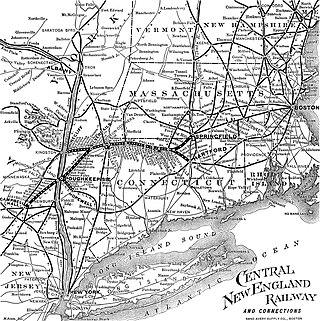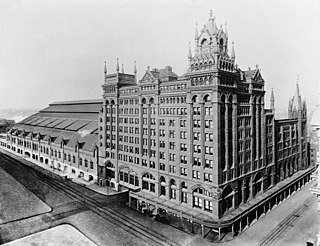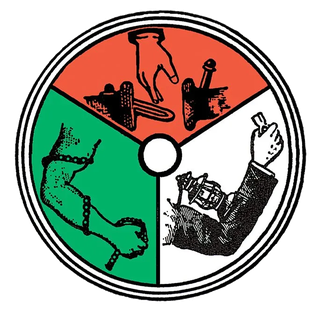The Erie Railroad was a railroad that operated in the Northeastern United States, originally connecting Pavonia Terminal in Jersey City, New Jersey, with Lake Erie at Dunkirk, New York. The railroad expanded west to Chicago following its 1865 merger with the former Atlantic and Great Western Railroad, also known as the New York, Pennsylvania and Ohio Railroad.

The Alaska Railroad is a Class II railroad that operates freight and passenger trains in the state of Alaska. The railroad's mainline runs between Seward on the southern coast and Fairbanks, near the center of the state. It passes through Anchorage and Denali National Park, to which 17% of visitors travel by train.

The Cincinnati, Lebanon and Northern Railway (CL&N) was a local passenger and freight-carrying railroad in the southwestern part of the U.S. state of Ohio, connecting Cincinnati to Dayton via Lebanon. It was built in the late 19th century to give the town of Lebanon and Warren County better transportation facilities. The railroad was locally known as the "Highland Route", since it followed the ridge between the Little and Great Miami rivers, and was the only line not affected by floods such as the Great Dayton Flood of 1913.

The Central New England Railway was a railroad from Hartford, Connecticut, and Springfield, Massachusetts, west across northern Connecticut and across the Hudson River on the Poughkeepsie Bridge to Maybrook, New York. It was part of the Poughkeepsie Bridge Route, an alliance between railroads for a passenger route from Washington to Boston, and was acquired by the New York, New Haven & Hartford Railroad in 1904. The New Haven ran the CNE as a separate company until finally merging it in 1927. The vast majority of the system was abandoned by the 1930s and 1940s. Surviving portions of the Central New England Railway are operated by the Central New England Railroad and the Housatonic Railroad.

The Brotherhood of Locomotive Engineers and Trainmen (BLET) is a labor union founded in Marshall, Michigan, on 8 May 1863 as the Brotherhood of the Footboard. It was the first permanent trade organization for railroad workers in the US. A year later it was renamed the Brotherhood of Locomotive Engineers. The B of LE took its present name in 2004 when it became a division of the Rail Conference of the International Brotherhood of Teamsters (IBT).

Daniel Willard was an American railroad executive best known as the president of the Baltimore and Ohio Railroad (B&O) from 1910 to 1941. He served on or headed several government railroad commissions in World War I and appeared on the cover of Time magazine in 1932 due to his part in negotiating wage cuts in the Great Depression.

Andrew Cunningham McLaughlin was an American historian known as an authority on U.S. Constitutional history.

The Sheet Metal Workers' International Association was a trade union of skilled metal workers who perform architectural sheet metal work, fabricate and install heating and air conditioning work, shipbuilding, appliance construction, heater and boiler construction, precision and specialty parts manufacture, and a variety of other jobs involving sheet metal. On August 11, 2014, it merged with the United Transportation Union (UTU) to form the International Association of Sheet Metal, Air, Rail and Transportation Workers, known by the acronym, SMART.

The American Railway Engineering and Maintenance-of-Way Association (AREMA) is a North American railway industry group. It publishes recommended practices for the design, construction and maintenance of railway infrastructure, which are used in the United States and Canada.

Lucius Seymour Storrs was a geologist, financier, and notable railway official. He was president of the Connecticut Company, the American Electric Railway Association, the Los Angeles Railway Association, and the New England Investment and Security Company.

The Woman's Relief Corps (WRC) is a charitable organization in the United States, originally founded as the official women's auxiliary to the Grand Army of the Republic (GAR) in 1883. The organization was designed to assist the GAR and provide post-war relief to Union veterans. The GAR had been created as a "fraternal" organization and refused to allow women to join up until the creation of this auxiliary. It is largely dedicated to historical preservation of research and official documentation related to the WRC and GAR.

The Philadelphia, Baltimore and Washington Railroad (PB&W) was a railroad that operated in Pennsylvania, Delaware, Maryland, and the District of Columbia in the 20th century, and was a key component of the Pennsylvania Railroad (PRR) system. Its 131-mile (211 km) main line ran between Philadelphia and Washington. The PB&W main line is now part of the Northeast Corridor, owned by Amtrak.

The American Train Dispatchers Association or Train Dispatchers is an American trade union representing railroad workers. The Train Dispatchers belong to the AFL–CIO as one of the organization's smallest members.
Janney couplers are a semi-automatic form of railway coupling that allow rail cars and locomotives to be securely linked together without rail workers having to get between the vehicles. They are also known as American, AAR, APT, ARA, MCB, knuckle, Buckeye, tightlock, Henricot or Centre Buffer Couplers.

Grace Mann Brown was an American writer and spiritual leader. Her work was related to the New Thought Movement, Divine Science and Christian Science. Much of her work focused on spirituality, metaphysics, mysticism, esoteric and occult sciences.

The Order of Railway Conductors of America (ORC) was a labor union that represented train conductors in the United States. It has its origins in the Conductors Union founded in 1868. Later it extended membership to brakemen. In 1969 the ORC merged with three other unions to form the United Transportation Union.
Walter Theodore Krausch, known as W.T. Krausch (1868–1929), was an American architect, engineer, and inventor who worked for the Chicago, Burlington and Quincy Railroad (CB&Q) from the late 1880s to the 1920s.
Edward Alfred Harrison, known as E. A. Harrison, was an American architect who worked as a staff architect for the Atchison, Topeka & Santa Fe Railway, with offices in Topeka, Kansas, and later in Chicago, Illinois.













